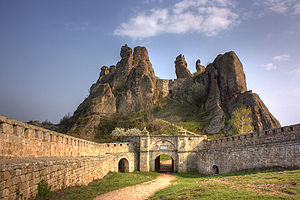
Belogradchik Fortress
Encyclopedia

Turkish language
Turkish is a language spoken as a native language by over 83 million people worldwide, making it the most commonly spoken of the Turkic languages. Its speakers are located predominantly in Turkey and Northern Cyprus with smaller groups in Iraq, Greece, Bulgaria, the Republic of Macedonia, Kosovo,...
kale), is an ancient fortress close to the northwestern Bulgaria
Bulgaria
Bulgaria , officially the Republic of Bulgaria , is a parliamentary democracy within a unitary constitutional republic in Southeast Europe. The country borders Romania to the north, Serbia and Macedonia to the west, Greece and Turkey to the south, as well as the Black Sea to the east...
n town of Belogradchik
Belogradchik
Belogradchik is a town in Vidin Province, Northwestern Bulgaria, the administrative centre of the homonymous Belogradchik Municipality. The town, whose name literally means "small white town," is situated in the foothills of the Balkan Mountains just east of the Serbian border and about 50 km...
and the town's primary cultural and historical tourist attraction, drawing, together with the Belogradchik Rocks
Belogradchik Rocks
The Belogradchik Rocks are a group of bizarrely shaped sandstone, limestone and conglomerate rock formations located on the western slopes of the Balkan Mountains near the town of Belogradchik in northwest Bulgaria...
, the main flow of tourists into the region. It is one of the best-preserved strongholds in Bulgaria and a cultural monument of national importance.
The fortress' walls are over 2 metres (6.6 ft) thick in the foundation and reaching up to 12 m (39.4 ft) in height. Three separate fortified yards exist that are connected with each other through gates. The fortress has a total area of 10210 square metres (109,899.5 sq ft). The Belogradchik Fortress was reconstructed to later become a proclaimed cultural monument. It is managed by the local historical museum authority.
The initial fortress was constructed during the time when the region was part of the Roman Empire
Roman Empire
The Roman Empire was the post-Republican period of the ancient Roman civilization, characterised by an autocratic form of government and large territorial holdings in Europe and around the Mediterranean....
. The rock formations in the area served as a natural protection, as fortified walls
Fortification
Fortifications are military constructions and buildings designed for defence in warfare and military bases. Humans have constructed defensive works for many thousands of years, in a variety of increasingly complex designs...
were practically only built from the northwest and southeast, with the yard being surrounded by rocks up to 70 m (229.7 ft) high from the other sides.
Initially, the Belogradchik Fortress served for surveillance
Surveillance
Surveillance is the monitoring of the behavior, activities, or other changing information, usually of people. It is sometimes done in a surreptitious manner...
and not strictly defense. Bulgarian tsar
Tsar
Tsar is a title used to designate certain European Slavic monarchs or supreme rulers. As a system of government in the Tsardom of Russia and Russian Empire, it is known as Tsarist autocracy, or Tsarism...
of Vidin
Vidin
Vidin is a port town on the southern bank of the Danube in northwestern Bulgaria. It is close to the borders with Serbia and Romania, and is also the administrative centre of Vidin Province, as well as of the Metropolitan of Vidin...
Ivan Stratsimir extended the old fortress in the 14th century, building fortified garrisons before the existing rock massifs. During Stratsimir's rule, the Belogradchik Fortress became one of the most important strongholds in the region, second only to the tsar's capital fortress of Vidin, Baba Vida
Baba Vida
Baba Vida is a medieval fortress in Vidin in northwestern Bulgaria and the town's primary landmark. It consists of two fundamental walls and four towers and is said to be the only entirely preserved medieval castle in the country....
.
During the Ottoman
Ottoman Empire
The Ottoman EmpireIt was usually referred to as the "Ottoman Empire", the "Turkish Empire", the "Ottoman Caliphate" or more commonly "Turkey" by its contemporaries...
conquest of Bulgaria, the fortress was captured by the Ottomans in 1396. They were forced to further expand the stronghold due to the intensified hajduk
Hajduk
Hajduk is a term most commonly referring to outlaws, highwaymen or freedom fighters in the Balkans, Central- and Eastern Europe....
and insurrectionist activity in the region.
Considerable changes to the fortress were made in the early 19th century. These changed were typical for the Ottoman castle architecture of the period, a full reorganization being carried out, as well as additional expansion. Typically Europe
Europe
Europe is, by convention, one of the world's seven continents. Comprising the westernmost peninsula of Eurasia, Europe is generally 'divided' from Asia to its east by the watershed divides of the Ural and Caucasus Mountains, the Ural River, the Caspian and Black Seas, and the waterways connecting...
an elements were added to the Belogradchik Fortress owing to the French
France
The French Republic , The French Republic , The French Republic , (commonly known as France , is a unitary semi-presidential republic in Western Europe with several overseas territories and islands located on other continents and in the Indian, Pacific, and Atlantic oceans. Metropolitan France...
and Italian
Italy
Italy , officially the Italian Republic languages]] under the European Charter for Regional or Minority Languages. In each of these, Italy's official name is as follows:;;;;;;;;), is a unitary parliamentary republic in South-Central Europe. To the north it borders France, Switzerland, Austria and...
engineers that participated in the expansion.
The stronghold had an important role in the Ottoman suppression of the Bulgarian Belogradchik Uprising of 1850. It was last used in warfare during the Serbo-Bulgarian War
Serbo-Bulgarian War
The Serbo-Bulgarian War was a war between Serbia and Bulgaria that erupted on 14 November 1885 and lasted until 28 November the same year. Final peace was signed on 19 February 1886 in Bucharest...
in 1885.

